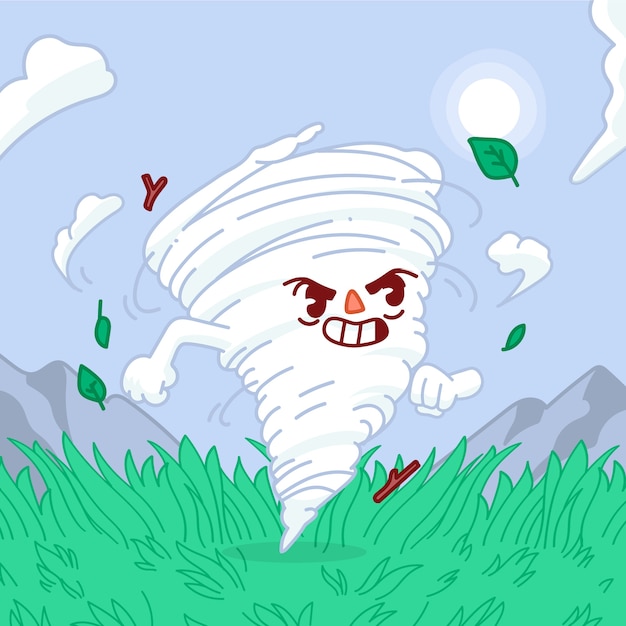Tornado Fun Facts

Tornadoes are like nature’s roller coasters, but definitely not for the faint of heart.
Did you know that the word tornado comes from the Spanish word tornar, meaning to turn?
Tornadoes can reach wind speeds of over 300 miles per hour. That’s faster than most Formula 1 cars!
The largest tornado ever recorded was 2.6 miles wide. That’s wider than some small towns!
Tornadoes can form from any type of thunderstorm. They’re like the wild child of the storm family.
Tornadoes often make a distinct roaring sound. It’s like nature’s way of announcing its arrival.
Tornadoes can last anywhere from a few seconds to more than an hour. Mother Nature likes to keep us guessing.
If you see a greenish color in the sky during a tornado, seek shelter immediately. It’s a sign of imminent danger.
Tornadoes can form over both land and water. They’re not picky about their playground.
The United States experiences more tornadoes than any other country in the world. We like to keep things exciting.
Tornadoes can produce hailstones the size of baseballs. That’s definitely not something you want to catch.
The average tornado moves at a speed of about 30 miles per hour. That’s faster than your morning commute!
Tornadoes can create an eerie calmness before they strike. It’s like the calm before the storm on steroids.
Tornadoes often leave a distinct path of destruction called a tornado track. It’s like nature’s signature.
Tornado Fun Facts part 2
Tornadoes can form in nearly any part of the world, except Antarctica. Even Mother Nature needs a break sometimes.
The peak tornado season in the United States is from March to August. It’s like a summer blockbuster with a twist.
Tornadoes can cause power outages by damaging power lines. It’s like nature playing hide-and-seek with electricity.
Tornadoes can occur during any time of the day, but they’re most common in the late afternoon and early evening. Mother Nature loves a good sunset show.
Tornadoes can be categorized based on their intensity using the Enhanced Fujita (EF) scale. It’s like tornadoes have their own rating system.
Tornadoes can occur in urban areas, causing even more destruction. It’s like nature playing a game of urban chaos.
If you’re caught in a tornado, the best place to seek shelter is in a small, windowless interior room on the lowest level of your home. It’s like setting up a fortress against nature’s fury.
Tornadoes can produce a phenomenon called a fire whirl, where flames are caught up in the tornado’s vortex. It’s like fire and wind doing a dangerous dance.
Tornadoes can occur in all 50 states, but they’re most common in the central part of the United States. It’s like the heart of tornado alley.
Tornadoes can send debris flying at incredible speeds, making them extremely dangerous. It’s like playing dodgeball with nature’s fury.
Tornadoes can create a visible vortex, giving them a unique and awe-inspiring appearance. It’s like nature’s very own twister.
Tornadoes can form from rotating supercell thunderstorms. It’s like the storm has a secret weapon up its sleeve.
Tornadoes can cause damage to structures in a variety of ways, including the strong winds and flying debris. It’s like a destructive combo from Mother Nature.
Tornadoes can cause a sudden drop in atmospheric pressure, making your ears pop. It’s like taking an unplanned trip to the mountains.
Tornadoes can be unpredictable, changing direction and intensity with little warning. It’s like nature’s way of keeping us on our toes.
Tornadoes can produce multiple vortexes, creating a mesmerizing sight. It’s like nature showing off its artistic talents.
Tornadoes can form in the wake of hurricanes, adding insult to injury. It’s like nature saying, I’m not done yet.
Tornadoes can toss cars and even houses like they’re toys. It’s like nature playing a game of extreme catch.
Tornadoes can cause a phenomenon called storm chasing, where people actively seek out tornadoes for scientific research or adrenaline-fueled thrills. It’s like a real-life adventure movie.
Tornadoes can create incredible lightning displays. It’s like nature’s fireworks show on steroids.
Tornadoes can skip along the ground, leaving a path of destruction interrupted by moments of untouched areas. It’s like nature’s twisted game of hopscotch.
Tornadoes can generate their own electromagnetic fields, interfering with communication and electronic devices. It’s like nature’s way of saying, No service available.
Tornadoes can vary in size, from small and narrow funnels to large and wide monsters. It’s like nature showing off its range.
Tornadoes can spin in a counterclockwise direction in the Northern Hemisphere and a clockwise direction in the Southern Hemisphere. It’s like nature performing a majestic dance around the Earth.
Tornadoes can create a mesmerizing green glow, caused by the scattering of sunlight through the storm’s hail and rain. It’s like a natural light show from above.
Tornadoes can have lifespans ranging from a few minutes to several hours. It’s like nature’s own fleeting performance.
Tornadoes can be caused by temperature and moisture gradients interacting with wind shear. It’s like a delicate balance of weather conditions gone awry.
Tornadoes can uproot trees and strip them of their branches, leaving behind a barren landscape. It’s like nature’s way of rearranging things.
Tornadoes can be tracked and predicted using Doppler radar and storm spotters. It’s like a high-stakes game of hide-and-seek with Mother Nature.
Tornadoes can cause a mesmerizing dust cloud to form around them, obscuring their lower portion. It’s like nature wrapping itself in a mysterious veil.
Tornadoes can leave behind a trail of destruction, but they also remind us of the immense power and beauty of the natural world. It’s like a reminder to respect and appreciate the forces of nature.